Probability – Complete Guide For Class 11 Math Chapter 14
Our learning resources for Mathematics Class 11 ‘Probability’ chapter 14 are designed to ensure that you grasp this concept with clarity and perfection. Whether you’re studying for an upcoming exam or strengthening your concepts, our engaging animated videos, practice questions, and notes offer you the best of integrated learning with interesting explanations and examples.
Our comprehensive approach ensures that you have access to everything you need to have an in-depth understanding of the chapter Probability. From detailed notes to interactive exercises, our materials are tailored to meet your learning needs and help you excel in your studies. Get ready to dive into an enriching educational experience that will make mastering this chapter a breeze.
What Is Probability?
Probability is the measure of the likelihood that an event will occur, expressed as a number between 0 and 1. Chapter 14 of Class 11 Mathematics introduces the fundamental principles of probability, which is the study of uncertainty and chance. This chapter covers basic concepts such as experiments, sample spaces, and events. Students learn to calculate the probability of simple and compound events using classical and empirical methods. Key topics include the probability of independent and dependent events, as well as the use of probability rules to solve real-world problems. By understanding these concepts, students can quantify uncertainty and make informed predictions based on probabilistic reasoning.
Probability is a measure of the likelihood of an event occurring. For example, if you have a spinner divided into four equal sectors colored yellow, blue, green, and red, the probability of landing on the blue sector is calculated as follows:
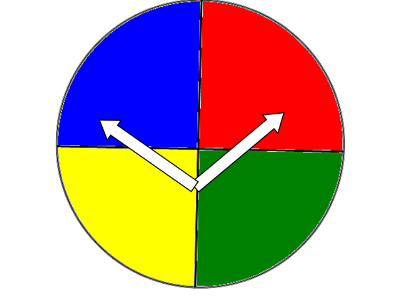
P(Blue) = Number of favorable outcomes/Total number of possible outcomes = 14
This is known as the classical approach to probability. However, this approach can be limited in scenarios where outcomes are not equally likely, such as predicting rain.
Random Experiments
Random experiments are those that have multiple possible outcomes and cannot be predicted in advance. For example, tossing a coin or rolling a die.
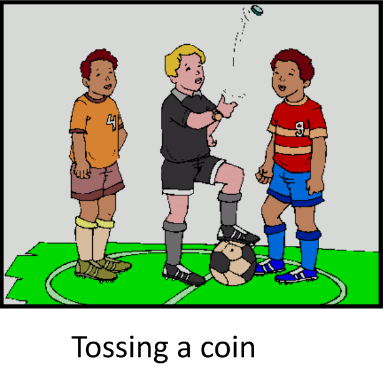
Outcomes
Possible results of a random experiment are called outcomes. For example, rolling a die yields outcomes 1, 2, 3, 4, 5, or 6.
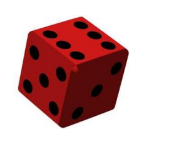
Sample Space and Sample Points
The sample space, denoted as S, is the set of all possible outcomes of a random experiment. Each element of the sample space is called a sample point.
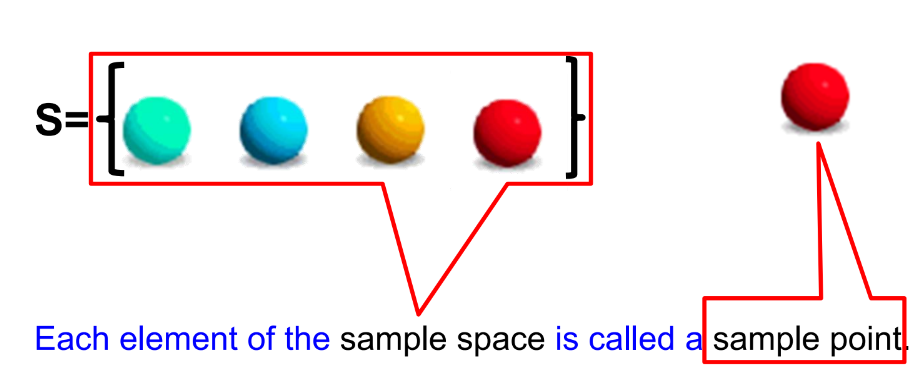
Example: Tossing a Coin
- Sample Space: S = {H,T}
- Sample Points: H (Head), T (Tail)
Event
An event is any subset of the sample space. For example, when rolling a die:
- Sample Space: S = {1,2,3,4,5,6}
- Events:
- A = {1,2,3} (Numbers less than or equal to 3)
- B={3,6} (Multiples of 3)
Event Occurrence
- If the die shows 1 or 2, only event A has occurred.
- If the die shows 6, only event B has occurred.
- If the die shows 3, both events A and B have occurred.
Simple Event and Compound Event
- Simple Event: A subset with only one element.
- Example: Rolling a die where S = {1,2,3,4,5,6}
- Simple Events: {1},{2},{3},{4},{5},{6}
- Example: Rolling a die where S = {1,2,3,4,5,6}
- Compound Event: A subset with more than one element.
- Example: Tossing two coins
- Sample Space: S = {HH, HT, TH, TT}
- Event E: “Exactly one head appears” E={HT, TH}
- Example: Tossing two coins
Sure Event and Impossible Event
- Sure Event: An event associated with a random experiment is called a sure event if it always occurs whenever it performs. In other words, the whole sample space S is called the sure event.
- Example: Getting either an even or odd number when throwing a die.
- Impossible Event: An event associated with a random experiment is called an impossible event if it never occurs whenever it is performed. In other words, the empty set is called the impossible event.
- Example: Rolling a 7 on a standard die.
Algebra of Events
As stated in the algebra of events, events can be combined using set operations:
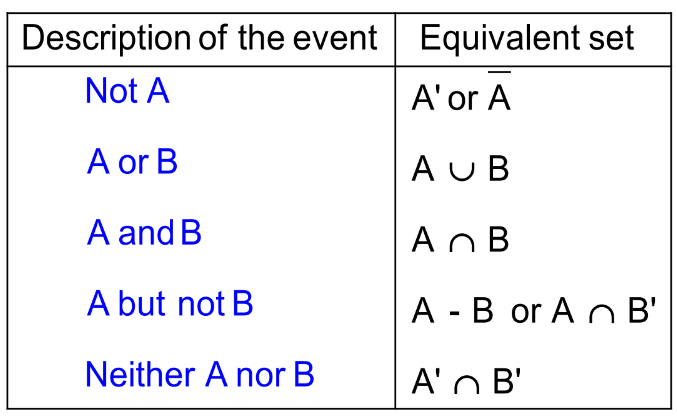
The Event ‘Not A’
For an event A, there corresponds to another event A is called the complementary event to A. It is also called ‘not A’.
The Event ‘A or B’
The union of events A and B is called the event ‘A or B’. It is denoted by the set A ∪ B.
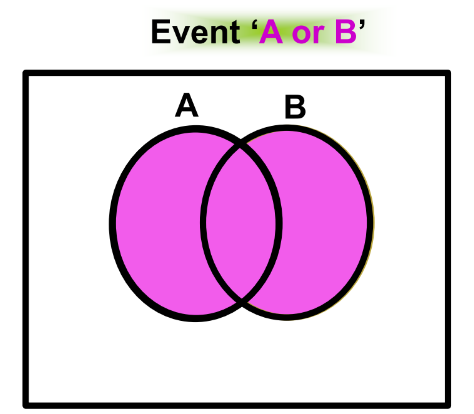
The Event ‘A and B’
The intersection of events A and B is known as the event ‘A and B’. It is denoted by the set A ∩ B.

The Event ‘A but not B’
We know that (A-B) is the set of all those elements, which are in A but not in B. So the (A-B) is known as the event ‘A but not B’.
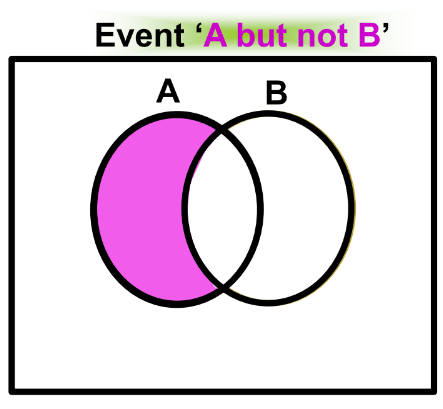
The Event ‘neither A nor B’
We know that the set (A∪B)’ = A’ ∩ B’ is the set of all those elements, which are not in A and not in B.
So the set (A∪B)’ or A’ ∩ B’ is known as the event: neither A nor B.
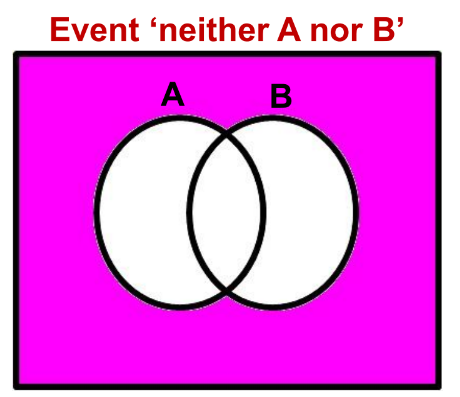
Example 1: Tossing Three Coins
- Sample Space: S = {HHH, HHT, HTH, THH, HTT, THT, TTH, TTT}
- Events:
- A: “Exactly one tail appears” A = {HHT,HTH,THH}
- B: “Exactly two tails appear” B = {HTT,THT,TTH}
- Set Representations:
- A∪B = {HHT,HTH,THH,HTT,THT,TTH}
- A∩B = ∅
- A−B = {HHT, HTH, THH}
- A′ = {HTT, THT, TTH, TTT, HHH}
- A′∩B′ = {TTT,HHH}
- Events:
Mutually Exclusive Events
Events are mutually exclusive if the occurrence of one prevents the occurrence of the other.
Example: Rolling a die
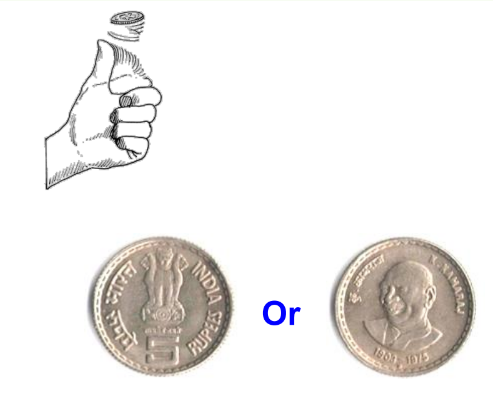
- Event A: “Number less than or equal to 3” A = {1,2,3}
- Event B: “Number greater than 3” B = {4,5,6}
- Intersection: A∩B = ∅
Exhaustive Events
Events are exhaustive if their union covers the entire sample space.
Example: With sample space S = {1,2,3,4,5,6}
- Events: A = {1,2}, B = {1,2,3}, C = {4,5,6}
- Union: A ∪ B ∪ C = S
Axiomatic Approach to Probability
In this approach, for a given sample space probability is considered as a function that assigns a non-negative real number P(A) to every event A. This approach of probability is based upon certain axioms.
Let the Sample space S = {w1,w2,w3,……..wn}
For the axiomatic definition of probability, the following axioms hold:
- 0 ≤ P(A) ≤ 1 for each wi ∈ S
- P(w1) + P(w2) + P(w3) + ……….P(wn) = 1
- For any event A, P(A) = ∑P(wi), where wi ∈ A
Example: Tossing a coin
In an experiment ‘ ‘ we assign the number 1/2 to each of the outcomes H and T, then satisfy the axiomatic approach.
Let P(H) = 1/2 and P(T) = 1/2
This assignment satisfies the first two axioms i.e. 0 ≤ P(A) ≤ 1 and P(H) + P(T) = 1
Now, take P(H) = 1/8 and P(T) = 3/8 and check whether this assignment satisfies the conditions of the axiomatic approach.
Probability of an Event
Example: Tossing three coins
- Sample Space: S = {HHH, HHT, HTH, THH, TTH, THT, HTT, TTT}

- Event A: “Exactly one T” A = {HHT,HTH,THH}}
- Event B: “At least two H” B = {HHT,HTH,THH,HHH}
- Probabilities:
- P(A) = 3/8
- P(B) = 4/8 = 1/2
This example satisfies the condition of the axiomatic approach.
Probabilities of Equally Likely Outcomes
Let a sample space of an experiment be S = {S1, S2, S3,…….Sn}
Let all the outcomes be equally likely to occur, i.e., the chance of occurrence of each simple event must be the same.
P(Si) = p, for all si ∈ S where 0 ≤ P ≤ 1.
p + p + p +…….+ p(n times) = 1
np =1
p = 1/n
Example: What is the probability that a ball selected from the following group, is red?
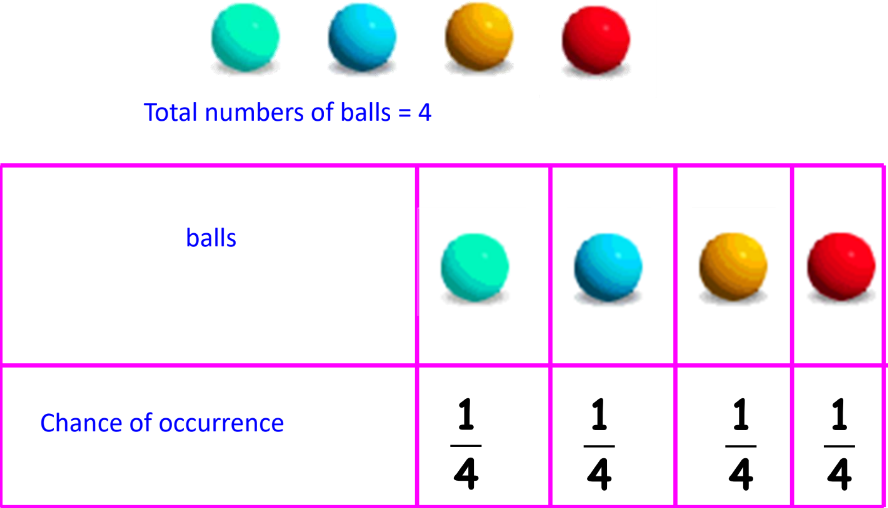
- Probability of selecting a red ball: 1/4
Probability of Event ‘A or B’
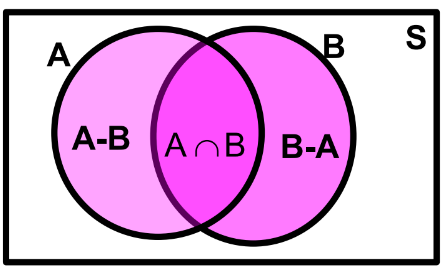
P(A∪B) = P(A) + P(B) − P(A∩B)
Example:
- Events:
- A = {3,6,9}
- B = {2,4,6,8,10}
- Probability:
P(A∪B) = 3/10 + 5/10 − 1/10 = 7/ 10
Probability of Event ‘not A’
P(A′) = 1 − P(A)
Example:

- Event A: {1,2,5,6}
- Sample Space: {1,2,3,…,10}
- Probability:
- P(A) = 4/10 = 2/5
- P(A′) = 1 − 2/5 = 3/5
So, P(A′) = 1 – P(A)
Also, we know that A’ and A are mutually exclusive and exhaustive events i.e., ∪ ∩
A ∩ A’ = ∅ and A ∪ A’ = S
P( A ∪ A’ ) = P(S)
Now, P(A) + P(A’) = 1
P(A’) = P(not A) = 1- P(A)
Let’s Conclude
In conclusion, Chapter 14 of Class 11 Mathematics, titled Probability, equips students with the essential tools to understand and apply the principles of chance and uncertainty. With our comprehensive learning resources, you can confidently explore the key concepts covered in the chapter, such as experiments, sample spaces, events, and the algebra of events. By mastering the content in the Probability chapter, you’ll be well-prepared to tackle real-world problems and make informed predictions based on statistical reasoning.
Whether you’re engaging with our animated videos, solving practice questions, or reviewing detailed notes, our integrated approach to learning ensures that you grasp the concepts thoroughly. Embrace the journey of mastering Probability and excel in your academic pursuits. Let’s make learning this chapter an enjoyable and enriching experience!
Practice questions on Chapter 14 - Probability
Get your free Chapter 14 - Probability practice quiz of 20+ questions & detailed solutions
Practice Now








